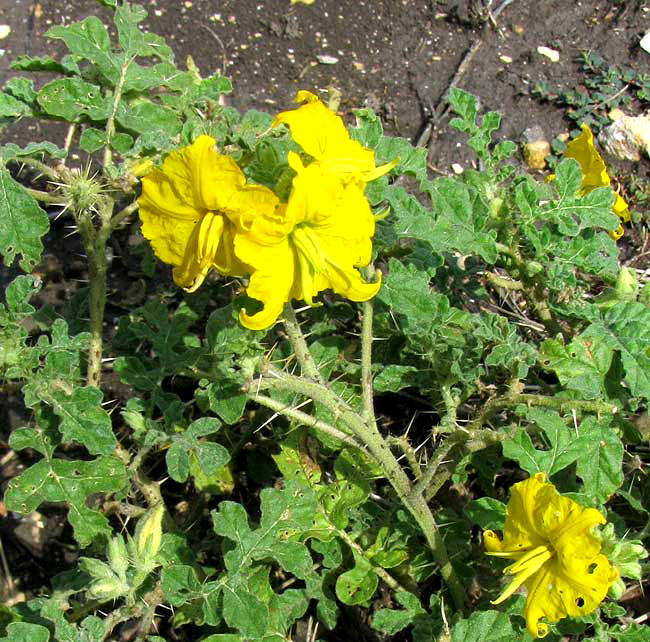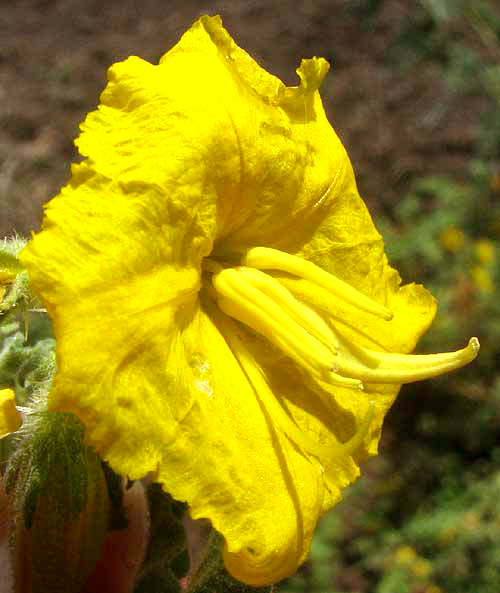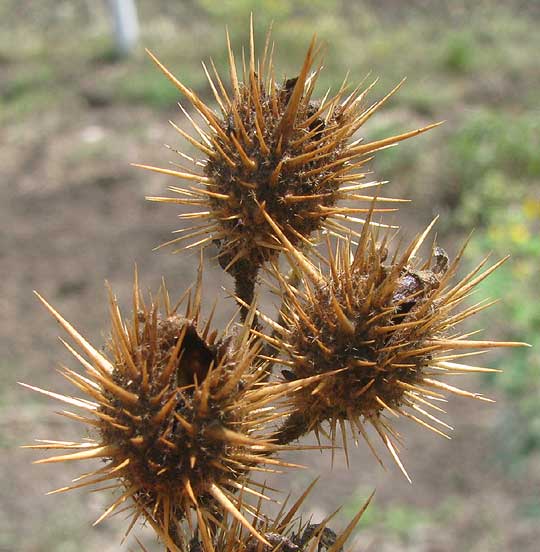Excerpts from Jim Conrad's
Naturalist Newsletter

from the the September 23, 2012 Newsletter issued from the valley of the Dry Frio River in northern Uvalde County, southwestern Texas, on the southern border of the Edwards Plateau; elevation ~1750m (~5750 ft); N29.62°, W99.86°; USA
BUFFALO BUR
I can go barefooted around the cabin, but every now and then I do get a sticker in my foot. You can see the main culprit above. That plant is only about a foot tall, but one that's taken over an abandoned flowerbed where the soil is rich and deep stands a yard tall (1m). Even the spines on plants that were chopped down months ago and now are brown and humusy remain sharp and stiff enough to stick you, so just avoiding the easy-to-recognize plant isn't enough to keep away from foot-stabbing spines.
Besides the spines, which remind us of the barnyard weed called Horse Nettle, in the picture notice that the deeply lobed leaves -- a good one is in the picture's upper-left corner -- look like potato leaves, and the flowers are similar to tomato flowers. Well, Horse Nettle, the Potato and the Tomato all are members of the Nightshade Genus Solanum, of the Nightshade Family, the Solanaceae, so it shouldn't surprise us that our foot-stabbing plant also is a Solanum. It's SOLANUM ROSTRATUM, often called Buffalo Bur. Buffalo Bur is native to the US Southwest, but it's tough and aggressive enough to have become invasive throughout the US and much of Canada.
It's always interesting to look at a Solanum flower, so a close-up of a Buffalo Bur blossom is shown below:

The anthers -- the part of the stamen in which pollen is formed -- are the most distinctive part of the flower. In our Solanum blossom they look like a clump of slender bananas in the blossom's center. It's normal for Solanum that there are five anthers, but notice that four of the anthers are alike, while the fifth is much enlarged. Also notice that, unlike the vast majority of anthers in other flowers, these anthers do not split open to release their pollen along their sides, but rather each anther tip bears two tiny pores through which the pollen exists. This is something special about the genus Solanum.
Below the clump of anthers you can also see the slender, upward-curving style, which is the ovary's neck. Pollen from other flowers lands on the stigma at the style's tip, germinates, and sends a rootlike, male-sex-germ-carrying pollen tube down through the style to the ovary, where fertilization takes place.
The very spiny fruits -- which botanically are berries because they contain several seeds, don't split open upon maturity, and are more pulpy than dry -- are about 3/8ths inch across (1cm). That's a close-up below:

Buffalo Bur, like many of its fellow nightshades, is toxic. However, few herbivores would want to eat such a prickly plant, so you don't hear much about Buffalo Bur poisoning.